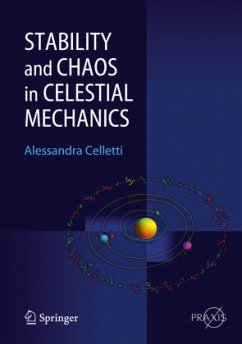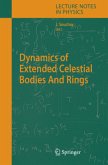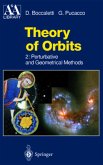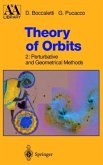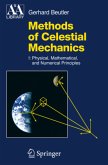This book presents classical celestial mechanics and its interplay with dynamical systems in a way suitable for advance level undergraduate students as well as postgraduate students and researchers. First paradigmatic models are used to introduce the reader to the concepts of order, chaos, invariant curves, cantori. Next the main numerical methods to investigate a dynamical system are presented. Then the author reviews the classical two-body problem and proceeds to explore the three-body model in order to investigate orbital resonances and Lagrange solutions. In rotational dynamics the author details the derivation of the rigid body motion, and continues by discussing related topics, from spin-orbit resonances to dumbbell satellite dynamics.
Perturbation theory is then explored in full detail including practical examples of its application to finding periodic orbits, computation of the libration in longitude of the Moon. The main ideas of KAM theory are provided including a presentation of long-term stability and converse KAM results. Celletti then explains the implementation of computer-assisted techniques, which allow the user to obtain rigorous results in good agreement with the astronomical expectations. Finally the study of collisions in the solar system is approached.
The last decades have marked the beginning of a new era in Celestial Mech- ics. The challenges came from several di?erent directions. The stability theory of nearly integrable systems (a class of problems which includes many models of - lestial Mechanics) pro?ted from the breakthrough represented by the Kolmogorov Arnold Moser theory, which also provides tools for determining explicitly the - rameter values allowing for stability. A con?nement of the actions for exponential times was guaranteed by Nekhoroshev s theorem, which gives much information about the geography of the resonances. Performing ever-faster computer simu- tionsallowedustohavedeeperinsightsintomanyquestionsofDynamicalSystems, most notably chaos theory. In this context several techniques have been developed to distinguish between ordered and chaotic behaviors. Modern tools for computing spacecraft trajectories made possible the realization of many space missions, es- cially the interplanetary tours, which gave a new shape to the solar system with a lot of new satellites and small bodies. Finally, the improvement of observational techniques allowed us to make two revolutions in the sky: the solar system does not end with Pluto, but it extends to the Kuiper belt, and the solar system is not unique, but the universe has plenty of extrasolar planetary systems. Cookingalltheseingredientstogetherwiththeclassicaltheoriesdevelopedfrom the 17th to the 19th centuries, one obtains themodern Celestial Mechanics.
Perturbation theory is then explored in full detail including practical examples of its application to finding periodic orbits, computation of the libration in longitude of the Moon. The main ideas of KAM theory are provided including a presentation of long-term stability and converse KAM results. Celletti then explains the implementation of computer-assisted techniques, which allow the user to obtain rigorous results in good agreement with the astronomical expectations. Finally the study of collisions in the solar system is approached.
The last decades have marked the beginning of a new era in Celestial Mech- ics. The challenges came from several di?erent directions. The stability theory of nearly integrable systems (a class of problems which includes many models of - lestial Mechanics) pro?ted from the breakthrough represented by the Kolmogorov Arnold Moser theory, which also provides tools for determining explicitly the - rameter values allowing for stability. A con?nement of the actions for exponential times was guaranteed by Nekhoroshev s theorem, which gives much information about the geography of the resonances. Performing ever-faster computer simu- tionsallowedustohavedeeperinsightsintomanyquestionsofDynamicalSystems, most notably chaos theory. In this context several techniques have been developed to distinguish between ordered and chaotic behaviors. Modern tools for computing spacecraft trajectories made possible the realization of many space missions, es- cially the interplanetary tours, which gave a new shape to the solar system with a lot of new satellites and small bodies. Finally, the improvement of observational techniques allowed us to make two revolutions in the sky: the solar system does not end with Pluto, but it extends to the Kuiper belt, and the solar system is not unique, but the universe has plenty of extrasolar planetary systems. Cookingalltheseingredientstogetherwiththeclassicaltheoriesdevelopedfrom the 17th to the 19th centuries, one obtains themodern Celestial Mechanics.
From the reviews: "The aim of this book is to demonstrate a modern aspects of celestial mechanics. ... The book contain a set of Appendices (A-G) good for quick reference to the literature ... . The present excellent book is devoted to advance level undergraduate students as well as postgraduate students and researchers. The author provided comprehensive literature, 175 items." (Nikolay Asenov Kostov, Google Bucher, June, 2010) "This book is a comprehensive introduction to problems of celestial mechanics appropriate for students, PhD students and specialists in the area." (Nikolay Asenov Kostov, Journal of Geometry and Symmetry in Physics, Vol. 20, 2010) "This book is a welcome addition to the literature on celestial mechanics. The book contains a great wealth of information. ... This book is suitable both for the beginner and the expert. ... The book's main strengths are the great amount of information packed in only 261 pages, which makes it suitable as an introduction, but also as a reference ... . In conclusion, I think the book would be a great ... addition to any dynamicist's library." (Manuele Santoprete, Mathematical Reviews, Issue 2011 d) "This book builds a well supported bridge between the maths of Hamiltonian dynamics and Celestial Mechanics. Both historical examples of dynamical systems and the mechanical details needed to work in Celestial Mechanics are clearly covered so that a student can gain working knowledge in both fields. ... this book a real pleasure to read. ... an ideal textbook for a graduate Physics/Astronomy class focusing on Celestial Mechanics ... . Students preparing to work on exo-planetary system dynamics should find this book a valuable resource." (Alice Quillen, Celestial Mechanics and Dynamical Astronomy, Vol. 110, 2011)

